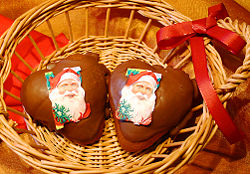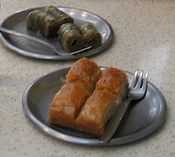Cookie (biscuit)
Cookies, or biscuits, are usually a sweet snack or dessert. They have a long history as they probably evolved from Middle Eastern pastries.
Cookie Definition
Whether it be called a cookie or a biscuit, cookies are popular worldwide. Cookies are known as biscuits through out most United Kingdom while in the United States the term cookie is used. No matter the terminology, a cookie is usually rolled, dropped, shaped or made into bar form and typically baked. Some cookies are “no bake” cookies meaning an oven is not used to finish the cooking process.
To clarify the terminology the following information is quoted from Food Timeline.org:
According to the Oxford English Dictionary, the term "biscuit" debuted in the 14th century. Primary definition here:
"Biscuit: 1. a. A kind of crisp dry bread more or less hard, prepared generally in thin flat cakes. The essential ingredients are flour and water, or milk, without leaven; but confectionery and fancy biscuits are very variously composed and flavoured. Even the characteristic of hardness implied in the name is lost in the sense ‘A kind of small, baked cake, usually fermented, made of flour, milk, etc.’ used, according to Webster, in U.S." The OED states "cookie" was introduced to the Engish language during the 18th century via the Dutch: "Cookie: 1. a. In Scotland the usual name for a baker's plain bun; in U.S. usually a small flat sweet cake (a biscuit in U.K.), but locally a name for small cakes of various form with or without sweetening. Also S. Afr. and Canad." [1]
The word cookie is probably derived from the Dutch word koekjes that is the diminutive for the word koek or cake. Cookies were first used as “test” cakes by bakers, according to some food historians. [2]
In Britain cookies are called biscuits. The root word for biscuits is probably derived from the term bis coctum which means twice baked. The latin term for this cookie is biscotti.[2] The term biscuit came from the Old French word biscoit. or twice baked. Seafaring sailors used to leave port with a good supply of twice baked savory crackers, or biscotti, as they provided food during long voyages.[1] Scandinavians prepared and ate a flat bread or biscuit. These breads were often made from oats, rye, barley and a small amount of wheat. [3] The very earliest cookies were probably from Persia and were sweet pastries. The pastry recipes, along with the spices, were brought to Europe by the Crusaders when they returned home from the Middle East.[1][2]
During the 17th, 18th and 19th centuries cookies evolved to include the addition of sugar, along with the use of honey, while adding the ingredient baking soda to help add leavening. Cookies were often baked at home. Some popular early cookies included jumbles, gingerbread and macaroons. Later popular cookies included butter cookies and shortbread. [2]
Some cookies used hartshorn salt (ammonia bicarbonate) for leavening instead of baking soda or baking powder. Some Scandinavian and German cookie recipes still use this ingredient today.[4][5][6]
Baklava
While not a cookie, Baklava is a famous pastry attributed to Turkey. The country Turkey used to be part of the Persian Empire. Baklava is made filo pastry, honey and chopped nuts. Earlier forms of Baklava were made from layered bread or noodle paste. In fact, the “...Janissary troops stationed in Istanbul used to march to the palace, where every regiment was presented with two trays of baklava. They would...march back to their barracks in what was known as the Baklava Procession." This is one of the earliest records of baklava being made from filo dough and this recipe most likely came from the Topkapi palace in Istanbul.Pastries such as Baklava were probably a forerunner of the cookie. Rich pastries were made throughout the Middle East.[7]
Gingerbread
Medieval gingerbread was often made from honey, spices and breadcrumbs. An updated version uses honey, ginger (optional), breadcrumbs, saffron (optional) and red food coloring (optional).[8] Another form of gingerbread popular during Mediveal times was the familiar gingerbread cookie. These cookies were made with spices and sweetened. They were shaped to look like flowers, birds, animals and armor. [9]
In Germany Lebkuchen is the name for gingerbread. Often found at street festivals the cookie is usually baked in a heart shaped form and frosted.[9]
Chocolate Chip Cookie
Ruth Wakefield is credited with creating the chocolate chip cookie. Wakefield was famous for her butter drop cookies but ran out of the needed chocolate she used in her recipe. She substituted some chopped up semisweet chocolate and the chocolate chip cookie was created.[10][11]
Historic Receipts or Recipes
The following receipts or recipes are included as samples of early cookie or biscuit recipes. All the recipes are shown as originally published. Receipt is an older name for recipe.
Cup Jumbles.
Five tea-cups of flour, three of sugar, one heaped of butter, one of sweet cream, three eggs and the peel of one lemon grated, or nutmeg, or mace if you like; roll them thin, and bake in a quick oven.
Jackson Jumbles.
Three tea-cups of sugar, one of butter, five of flour, one tea-spoonful of salaeratus in a cup of sour cream and two eggs; bake in a quick oven; season them with the peel of a fresh lemon grated, and half a wine-glass of brandy.
Macaroons.
Blanch a pound of almonds, beat them in a mortar, and put with them a little rose water to keep them from oiling, the white of an egg, and a large spoonful of flour; roll a pound of loaf-sugar, and beat the whites of four eggs; beat them all together; shape them on white paper with a spoon, and bake them on tin plates in a slow oven; let them be quite cold before you remove them from the paper.
Naples Biscuit.
Beat twelve eggs till light; add to them a pound of dried flour and one of powdered sugar; beat all together till perfectly light; put in some rose water and nutmeg, and bike it in small shallow pans in a moderately heated oven.[12]
LEMON BISCUITS
- 1/2 lb. Flour
- 3 oz. Dripping--1d.
- 1 teaspoonful Baking Powder
- 3 oz. Sugar--1d.
- 1 Lemon--1d.
- 1 Egg--1d.
- Total Cost--4d.
- Time--10 Minutes.
Rub the dripping into the flour, stir in the sugar and baking powder, and grate over the rind of the lemon. Beat up the egg and strain in the lemon juice; add these to the dry ingredients, mix into a stiff dough, and knead for a few minutes. Roll out, cut into small biscuits, and bake in a quick oven for about ten minutes.[13]
References
<references>
- ↑ Jump up to: 1.0 1.1 1.2 http://www.foodtimeline.org/foodcookies.html. Retrieved on 2010-10-11. Cite error: Invalid
<ref>tag; name "Food Timeline" defined multiple times with different content Cite error: Invalid<ref>tag; name "Food Timeline" defined multiple times with different content - ↑ Jump up to: 2.0 2.1 2.2 2.3 The History of Cookies: The Origin of the Cookie. Retrieved on 2010-10-11. Cite error: Invalid
<ref>tag; name "The Nibble Great Food Finds" defined multiple times with different content Cite error: Invalid<ref>tag; name "The Nibble Great Food Finds" defined multiple times with different content Cite error: Invalid<ref>tag; name "The Nibble Great Food Finds" defined multiple times with different content - ↑ Viking Foods. Retrieved on 2010-10-12.
- ↑ What is Hartshorn?. Retrieved on 2010-10-12.
- ↑ Questions and Answers: Hartshorn, Bakers' Amonia (Amonia Carbonate). Retrieved on 2010-10-12.
- ↑ Bakers' Amonia; Cookie Recipes. Retrieved on 2010-10-12.
- ↑ A Little Bit of Cookie History. Retrieved on 2010-10-12.
- ↑ Gingerbread. Retrieved on 2010-10-12.
- ↑ Jump up to: 9.0 9.1 Food & Think: A Brief History of Gingerbread. Retrieved on 2010-10-12.
- ↑ History of Chocolate Cookies & Ruth Wakefield. Retrieved on 2010-10-12.
- ↑ The History of Chocolate Chip Cookies (Original recipe featured). Retrieved on 2010-10-12.
- ↑ Title: Domestic Cookery, Useful Receipts, and Hints to Young Housekeepers, Date Unknown, Public Domain. Retrieved on 2010-10-12.
- ↑ The Art of Living in Australia, 1909. Retrieved on 2010-10-12.


